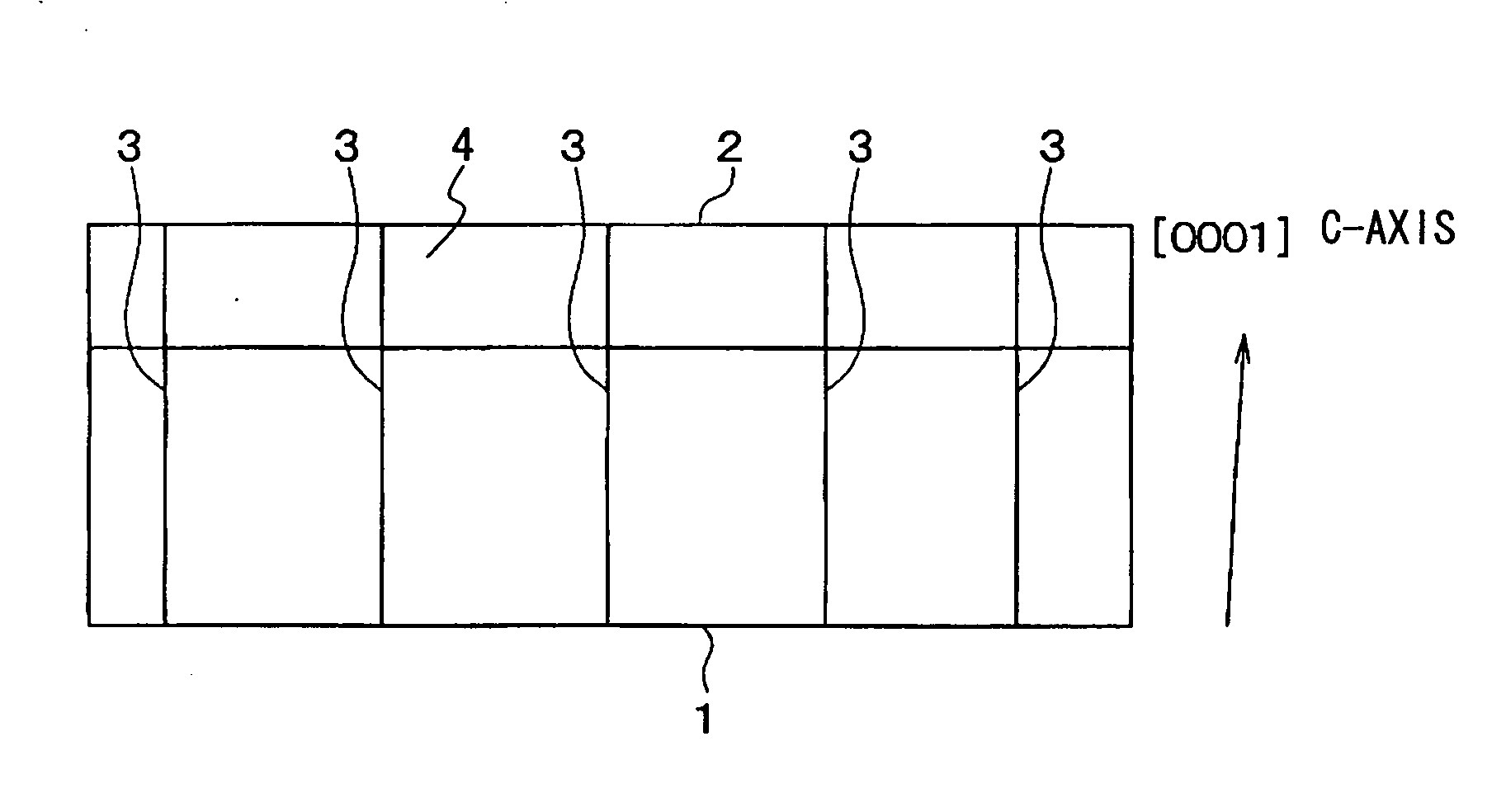SiC single crystal substrate, SiC single crystal epitaxial wafer, and SiC semiconductor device
- Summary
- Abstract
- Description
- Claims
- Application Information
AI Technical Summary
Benefits of technology
Problems solved by technology
Method used
Image
Examples
first embodiment
[0040]A first embodiment of the present invention will be explained. FIG. 1A is a cross sectional view of a SiC single crystal epitaxial wafer according to the present embodiment, and FIG. 1B is a vector diagram showing a relationship of an angle between a dislocation line of a threading dislocation in the SiC single crystal epitaxial wafer and a c-axis.
[0041]As shown in FIG. 1A, the SiC single crystal epitaxial wafer is formed such that an epitaxial film 2 is grown on a SiC single crystal substrate 1 made of 4H-SiC. A threading dislocation 3 is disposed in both of the SiC single crystal substrate 1 and the epitaxial film 2. At least the threading dislocation 3 formed in the epitaxial film 2 has an angle θ between a direction of a dislocation line and a [0001]-orientation c-axis equal to or smaller than 22.5 degrees (that is 19.5 degrees plus 3 degrees, i.e., =19.5°+3°). Here, the direction of the dislocation line of the threading dislocation 3 in the SiC single crystal substrate 1 ...
second embodiment
[0043]A second embodiment of the present invention will be explained. The present embodiment provides to align the direction of the dislocation line of the threading dislocation 3 to be restricted and more specifically, compared with the first embodiment. Here, the structure of the SiC single crystal epitaxial wafer according to the present embodiment is similar to that of the first embodiment. Thus, difference between the present and first embodiments will be explained.
[0044]In the SiC single crystal epitaxial wafer shown in FIG. 1A according to the present embodiment, all of the threading dislocations 3 disposed in the epitaxial film 2 are aligned such that the angle θ between the direction of the dislocation line and the [0001]-orientation c-axis is in a range between minus three degrees and plus three degrees with respect to a specific angle. For example, the specific angle is 19.5 degrees (i.e., the [2-203]-orientation direction) or 17 degrees (i.e., the [11-23]-orientation dir...
third embodiment
[0046]A third embodiment of the present invention will be explained. The present embodiment provides to align the direction of the dislocation line of the threading dislocation 3 to be restricted and more specifically to the direction of the c-axis as a center, compared with the first embodiment. Here, the structure of the SiC single crystal epitaxial wafer according to the present embodiment is similar to that of the first embodiment. Thus, difference between the present and first embodiments will be explained.
[0047]In the SiC single crystal epitaxial wafer shown in FIG. 1A according to the present embodiment, all of the threading dislocations 3 disposed in the epitaxial film 2 are aligned such that the direction of the dislocation line is in a range between minus three degrees and plus three degrees with respect to the [0001]-orientation c-axis.
[0048]Thus, the direction of the dislocation line of the threading dislocation 3 is aligned to the [0001]-orientation c-axis as a center. ...
PUM
| Property | Measurement | Unit |
|---|---|---|
| Angle | aaaaa | aaaaa |
| Angle | aaaaa | aaaaa |
| Angle | aaaaa | aaaaa |
Abstract
Description
Claims
Application Information
 Login to View More
Login to View More - R&D
- Intellectual Property
- Life Sciences
- Materials
- Tech Scout
- Unparalleled Data Quality
- Higher Quality Content
- 60% Fewer Hallucinations
Browse by: Latest US Patents, China's latest patents, Technical Efficacy Thesaurus, Application Domain, Technology Topic, Popular Technical Reports.
© 2025 PatSnap. All rights reserved.Legal|Privacy policy|Modern Slavery Act Transparency Statement|Sitemap|About US| Contact US: help@patsnap.com



